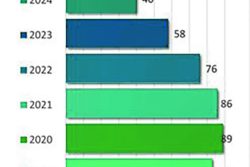By Gaulbert Sutherland
Investigations have been conducted into operations that breached mining regulations at Quartz Hill recently and the Guyana Geology and Mines Commission (GGMC) is pursuing charges, Commissioner of the regulatory body, William Woolford says.
He emphasized that the commission is proactive and undertakes systematic monitoring and the operation, whose tailings ponds were breached recently, was ordered to repair those even before it was highlighted in this newspaper. “We are on the ground and we are taking action”, he declared. Recently this newspaper had reported on breaches of the mining regulations that were occurring at the Quartz Hill mining district. The commissioner noted that it is an ongoing process and the GGMC is investigating and taking necessary action.
 Stressing that the GGMC has been taking action all along, Woolford pointed to the fines that were imposed on persons who had illegally invaded the ‘No Man’s Land’ area at Quartz Hill. Last year, when the area was opened and plots awarded to miners in a lottery, scores of others had descended on a portion of land that was the property of Omai at the time, and set up their operations. Heavy pollution of the Omai Creek resulted.
Stressing that the GGMC has been taking action all along, Woolford pointed to the fines that were imposed on persons who had illegally invaded the ‘No Man’s Land’ area at Quartz Hill. Last year, when the area was opened and plots awarded to miners in a lottery, scores of others had descended on a portion of land that was the property of Omai at the time, and set up their operations. Heavy pollution of the Omai Creek resulted.
In a recent interview, Woolford had noted that it was mostly persons, who owned equipment and who “had the means” that had illegally set up the operations in that area and not small miners. He stated that those persons, who turned out to be some of the larger miners, had knowingly and deliberately set out to go on the private property with their heavy equipment such as excavators and large dredges, to raid the property.
Woolford had noted that those miners would not have qualified for the lottery.
He said that the commission, over the space of several months issued cease work-orders and charges were filed. However, they opted to settle out of court, which is allowed under the Mining Act. Stabroek News has seen a list of 60 persons, who were fined, starting at $250,000 per dredge. A few were fined half a million dollars while one had to pay over $1M.
Divert
Earlier this year, that piece of land was formally relinquished by Omai and government made a decision to allow some persons to stay. “They made a decision that if they (miners) organize themselves into a committee that would help with self-regulation, they would be allowed to stay”, Woolford said. He noted that it worked for a while but then some operators tried to divert the Omai River and operate outside of the arrangements made. After this was recognized, the commission stepped in.
Meantime, the members of the committee signed contracts, a copy of which this newspaper has seen, for 12 months to operate in the area. A number of stipulations were included. The contracts would be up early next year.
The commission had last year also conducted an assessment with emphasis on tailings management in the area. According to the executive summary, a copy of which was provided to this newspaper, it was stated that work must continue with the small and medium scale operatives to develop practical and sustainable ways to overcome the challenges associated with tailings management. It stated that miners must also adjust their outlook and make the protection of the environment a primary objective and the cost incurred must be seen as necessary and not as an optional operating cost.
Among conclusions reached, it was stated that tailings management was done by many of the miners visited mainly because it was the only way to secure a good supply of water for their operation. It was noted that the mines that utilize excavators were better organized and showed greater potential for improvement in tailings management and the converse of this was also true. “The mines that do not utilize the service of excavators operate with little regard for the environment, disposing of their tailings in ways that do much harm even to their own operations”, the report said.
Recommendations made include that physical arrangements must be in place for proper management of tailings and dams and impoundments must be established so that clarification efforts can be successful. “Postponement of this type of preparation should not be permitted”.
Nursery
It was also stated that miners need to be advised on the safety aspects of dams and drainage structures they may wish to utilize in their operations and in this regard, the GGMC can consider developing codes of practice for the miners to use as they get more and more involved in tailings management. It said that standards should be set for these activities and the Codes of Practice produced by the GENCAPD project may be a good starting point. Another was that mining practices must be improved. “An acceptable mine plan which includes provision for environmental management must be insisted upon by the regulator and followed by the miner; mining without de-bushing seems to be a common practice. This does not lend itself to good environmental management and must be discouraged.”
Woolford said that things are always being done and monitoring is being done constantly and when breaches occur, action is taken. “The GGMC is proactive and we are giving strong direction and guidance in the mining industry”, he asserted. The GGMC has also done training and educational sessions for miners but attendance is an issue. Pamphlets on the mining regulations have also been produced. Recently Prime Minister, Samuel Hinds had said that the time for education has passed and sanctions will be applied to those in breach of regulations.
The commission is also in the process of setting up a nursery at Mahdia for seedlings and saplings to be used for restoring and re-vegetating mined out areas. Woolford said that by the end of this month, the building would be completed and by the end of the year, there would be at least 1000 seedlings and saplings to be used.
It was noted that the industry is an important one. Last year the mining and quarrying sector contributed $19.2B to the economy, which was 11.2% of the country’s total Gross Domestic Product (GDP). The small and medium scale gold and diamond mining sector also continued to lead the country in its percentage share of mineral production value last year, contributing 64.3%.








